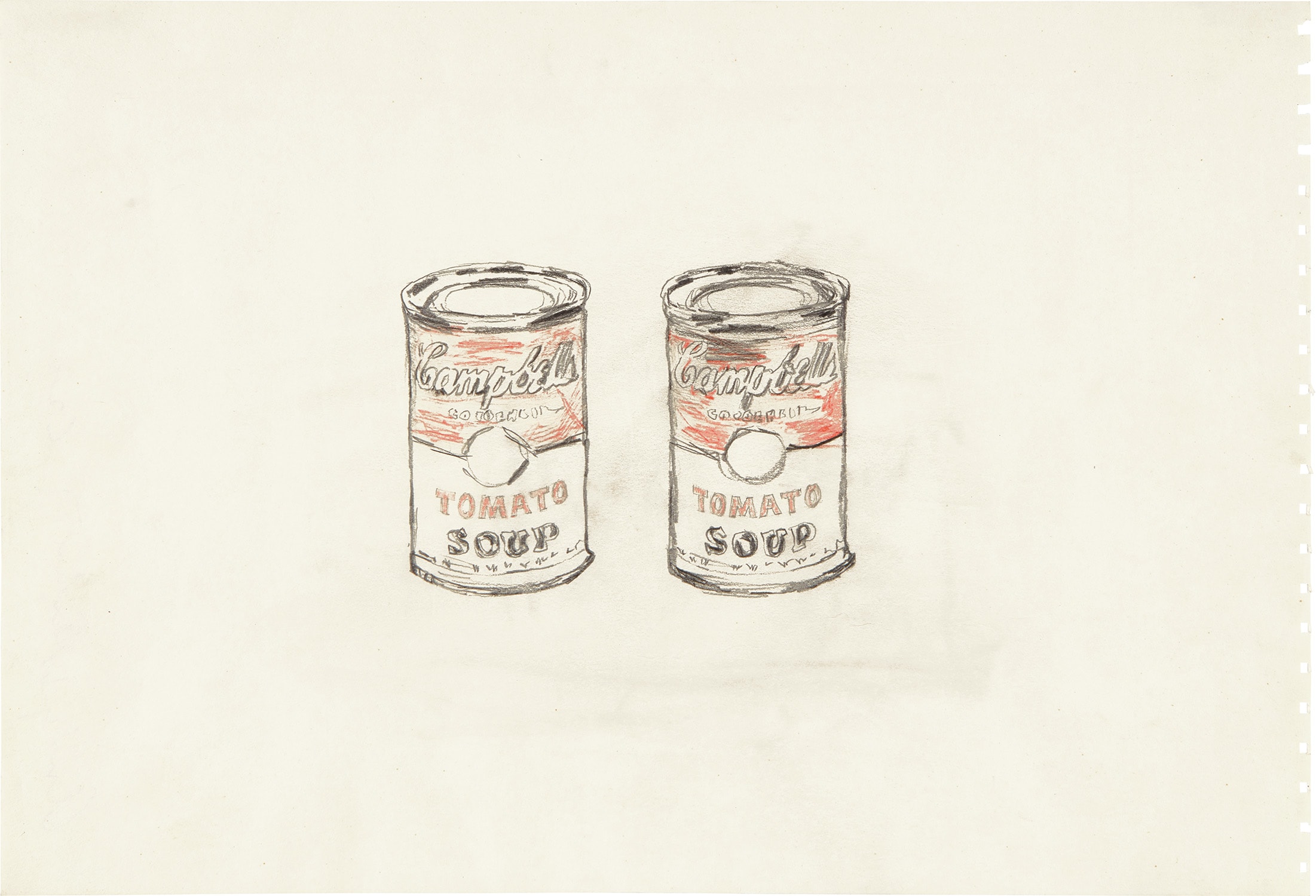

125Ο
Andy Warhol
Campbell's Soup Can #2
Full-Cataloguing
A testament to its importance within Warhol's oeuvre, Campbell's Soup Can #2’s history furthermore provides particular insight into the artist’s rapid ascent to the international scene. Acquired directly by Miles and Shirley Fiterman through Gordon Locksley and George Shea, of Locksley Shea Galleries in Minneapolis, the drawing forms part of a collection of works that the eminent duo purchased ahead of a long-lasting friendship with the artist. As one of the earliest works by Warhol in their extensive collection, Campbell's Soup Can #2 illustrates the couple’s sustained patronage of the artist at the dawn and core of their creative mission, and highlights the importance of Warhol's early contributions as he gained increasing momentum outside of Manhattan.
Campbell's Soup Can #2 highlights Warhol’s exquisite command of the medium. The practice of drawing had enthused the artist from his earliest days as an art student in the 1940s, to his first forays as an illustrator and his continued artistic activity materialized in striking stand-alone sketches, silkscreens, paintings and films. Throughout his life, he perceived the medium not just as a professional, artistic means to portray elements of the real world, but also as a cathartic force and activity in itself – one that he frequently undertook on his notoriously spiritual Sundays following Mass. Tied to the craft of drawing throughout his life, Warhol introduced new techniques that have since become inextricably associated to his persona and profusely replicated worldwide. Among which, the artist’s infamous "blotted-line" technique, carried out by layering a foundational drawing with ink or watercolor, before pressing the resulting image against a clean sheet of paper, displayed Warhol's ability to achieve a near perfect image whilst maintaining the manual and methodical process of drawing. Revealing erasures, smudges and altered forms, Warhol’s pristine blotted-lines highlight the unwavering life of the artist’s hand as it glides across the paper.
Using only a pencil and a sheet of paper, Campbell's Soup Can #2 displays the arresting simplicity and unfaltering control that underpin some of Warhol’s best work. Unlike the screen-printed Ferus Type soup cans, which most often erased all traces of the hand and enacted an exact replication of the Campbell’s logo, the present work is replete with vestiges of Warhol’s idiosyncratic and energetic hand. The faintly drawn yet detailed contours of the two Campbell's tins floating across the pictorial space conjure an image that is minimalistically simple yet eye-catching, while the hand-worked aspects of the composition evidence the artist’s inimitable precision and distinct draughtsmanship. Stripping away extraneous detail and focusing on the depicted items’ essential outlines, Warhol sheds light on the soup cans in a clear and straightforward manner that underscores their commanding presence as objects. Executed with varying shades and intensity of graphite, as well as shy carmine fillings that emulate the Campbell’s soup cans iconic red color, Warhol imparts the titular trademark product with charisma that brings attention to its bold conceptual countenance as a subject matter.
Portraying an iconic product of commercial branding, Campbell's Soup Can #2 indeed demonstrates Warhol’s incessant engagement with contemporary culture. When asked in 1963 why he had chosen to paint Campbell's soup cans, the artist candidly replied: "I used to drink it. I used to have the same lunch every day, for 20 years, I guess, the same thing over and over again" (Georg Frei and Neil Printz, eds., The Andy Warhol Catalogue Raisonné, Paintings and Sculpture 1961-1963, vol. 1, New York, 2002, p. 50). Campbell's Soup Can #2 thus functions as a commentary on the ubiquity of consumer products and more specifically canned foods, whilst revealing Warhol’s inextricable ties to Americana, which he concedes emanate warmth and intimacy despite their omnipresence in the multiplying bodegas and supermarkets of the country. The artist masterfully sheds light on a nationally coveted object that had become overexposed to the point of invisibility, and, by the same token, elevates the branded canned food's deemed commonplace status to that of art.
Bringing together a variety of elements that later became emblems of Warhol’s practice, Campbell's Soup Can #2 was executed in one of the most decisive years of the artist’s career. 1962 marked the advent of two pivotal shows for Warhol: his solo debut at Walter Hopps and Irving Blum’s legendary Ferus Gallery during the summer of 1962, which launched him to international acclaim, and his solo pop art exhibition at Eleanor Ward’s Stable Gallery in New York, later that year in November. Particularly significant within Warhol’s oeuvre, this year furthermore coincides with another of the artist’s most revered Pop breakthroughs: his iconic portraits of Marylin Monroe. Soon thereafter emerged his advertising paintings, which cemented his visibility and popularity within the art world. One can easily infer the genesis of this momentous progression upon observing Campbell's Soup Can #2: a testament to Warhol’s inimitable and enduring genius, this simply yet exquisitely achieved work on paper epitomizes his ability to condense multifarious social commentaries through humble yet striking imagery.
Andy Warhol
American | B. 1928 D. 1987Andy Warhol was the leading exponent of the Pop Art movement in the U.S. in the 1960s. Following an early career as a commercial illustrator, Warhol achieved fame with his revolutionary series of silkscreened prints and paintings of familiar objects, such as Campbell's soup tins, and celebrities, such as Marilyn Monroe. Obsessed with popular culture, celebrity and advertising, Warhol created his slick, seemingly mass-produced images of everyday subject matter from his famed Factory studio in New York City. His use of mechanical methods of reproduction, notably the commercial technique of silk screening, wholly revolutionized art-making.
Working as an artist, but also director and producer, Warhol produced a number of avant-garde films in addition to managing the experimental rock band The Velvet Underground and founding Interview magazine. A central figure in the New York art scene until his untimely death in 1987, Warhol was notably also a mentor to such artists as Keith Haring and Jean-Michel Basquiat.